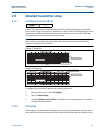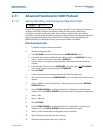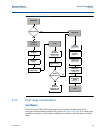
31
Reference Manual
00809-0100-4102, Rev AA
Section 3: Installation
May 2013
Installation
3.3 Considerations
3.3.1 Installation considerations
Measurement performance depends upon proper installation of the transmitter and impulse
piping. Mount the transmitter close to the process and use a minimum of piping to achieve best
performance. Also, consider the need for easy access, personnel safety, practical field
calibration, and a suitable transmitter environment. Install the transmitter to minimize
vibration, shock, and temperature fluctuation.
3.3.2 Wireless considerations
Power up sequence
The Power Module should not be installed on any wireless device until the Smart Wireless
Gateway is installed and functioning properly. This transmitter uses the Green Power Module
(order model number 701PGNKF). Wireless devices should also be powered up in order of
proximity from the Smart Wireless Gateway, beginning with the closest. This will result in a
simpler and faster network installation. Enable Active Advertising on the Gateway to ensure that
new devices join the network faster. For more information, see the Smart Wireless Gateway
Manual (Doc. No. 00809-0200-4420).
Electrical shock can result in death or serious injury.
Avoid contact with the leads and terminals.
Process leaks could result in death or serious injury.
Install and tighten all four flange bolts before applying pressure.
Do not attempt to loosen or remove flange bolts while the transmitter is in service.
Replacement equipment or spare parts not approved by Emerson Process Management for
use as spare parts could reduce the pressure retaining capabilities of the transmitter and
may render the instrument dangerous.
Use only bolts supplied or sold by Emerson Process Management as spare parts.
Improper assembly of manifolds to traditional flange can damage sensor module.
For safe assembly of manifold to traditional flange, bolts must break back plane of
flange web (i.e., bolt hole) but must not contact sensor module housing.
The Power Module with the wireless unit contains a primary lithium-thionyl chloride
battery. Each Power Module contains approximately 5.0 grams of lithium. Under normal
conditions, the Power Module materials are self-contained and are not reactive as long as
the batteries and the pack integrity are maintained. Care should be taken to prevent
thermal, electrical or mechanical damage. Contacts should be protected to prevent
premature discharge.


















